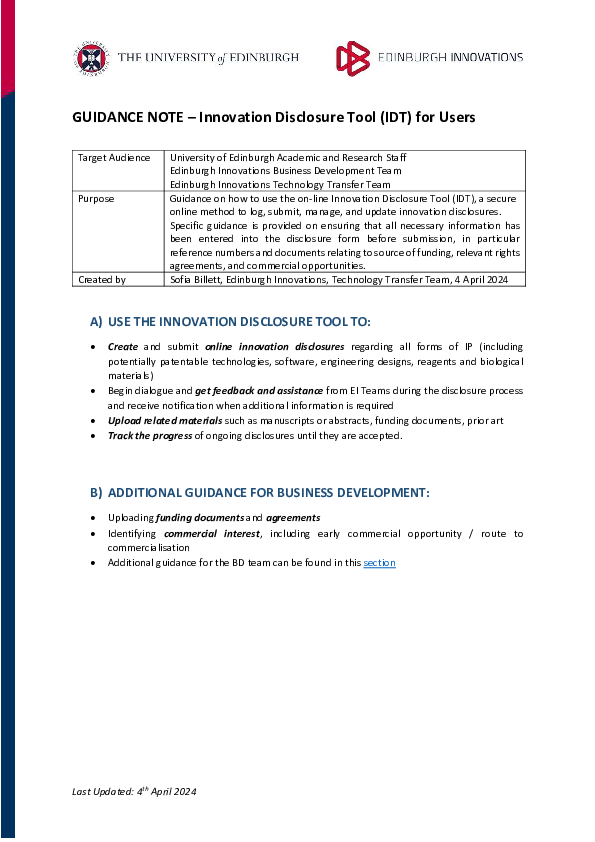Invention disclosure process
Do you have an idea, innovation, discovery or invention with a practical application? Edinburgh Innovation's experienced teams can help you explore commercial opportunities and create a tailored plan just for you!
Edinburgh Innovations (EI) has established a robust innovation disclosure process to guide you through the various stages of exploiting the intellectual property (IP) arising from your research. This process goes from evaluation of a new discovery to negotiating a licence agreement.
To support the process of initial innovation disclosure, we have a three-step innovation disclosure process.
Download the diagram as a pdf
1. Complete an online form using our Innovation Disclosure Tool (IDT).
This should be done in consultation with the EI Business Development contact within your School, Institute or Account Team. The IDT can be used to begin a dialogue with EI regarding all forms of IP, including potentially patentable technologies, software, engineering designs, reagents and biological materials.
The Innovation Disclosure Tool
Access the Tool at https://innovation-disclosures.ei.ed.ac.uk
-
The disclosure form can be completed in stages and partial information can be saved as a draft.
-
In order to carry out our review, it is important for us to collect information not only on the innovation itself, but also on the circumstances of its generation so that we can determine the rights that the University of Edinburgh may be able to go on to licence to third parties.
-
You will need to tell us about your innovation, what you have created, how it might be used and what problem it solves. tell us whether there are similar innovations, how yours is different and who you think might be interested in making use of your innovation to create practical impact.
-
You will also need to provide background information relating to the innovation. In particular how the research may have been funded, who has been involved and if you have published or spoken publicly about it.
-
It is important for us to understand who else has contributed to the invention, including ideas, materials and research tools, as well as the funding sources used to support the work.
University of Edinburgh staff can log in to the IDT using their EASE credentials. External users or students who have not previously used the IDT will receive an email inviting them to access the IDT, which they need to accept to allow them to view the innovation entry in the Portal.
The process of entering an innovation disclosure gives the inventor(s) an opportunity to work with their EI Business Development contacts to examine in a systematic manner everything they know about the commercial application of their invention, including ownership rights of any relevant intellectual property.
2. Innovation disclosure interview
Once all of the necessary information is available and agreed between the inventors and the Business Development contact as being complete, the innovation can be submitted online. EI will assign a Technology Transfer Manager to make an initial assessment, and provided the information is sufficiently complete, will meet with you for an invention disclosure interview to discuss the technology in more detail and consider commercial applications for your idea, discovery or invention. The completed disclosure form will aid these discussions.
Once this stage is complete, if appropriate for the type of IP, an assessment will be made of whether patent protection is required, especially if there is a publication deadline. However, commercialisation may still be possible for any form of technology even if patenting is not a possibility.
3. IP evaluation
All IP will be subject to a diligence process, to establish the rights that Edinburgh hold or can acquire, and the probability of achieving impact through licensing. Should the technology be adopted into the Technology Transfer Teams commercialisation process, we will attempt to identify the most appropriate licensees to develop and create impact from products and processes based on the technology.
In the particular case of potentially patentable IP, after the invention disclosure meeting, EI will undertake preliminary due diligence work with you (and any other inventors) to:
-
Establish ownership and commercialisation rights to the invention
-
Evaluate the potential to protect your idea, discovery or invention
-
Carry out an initial search and review of patents in the field
-
Carry out a preliminary review of the relevant market(s) to identify the product and market opportunity, assessing market needs and the competition
-
Construct a proof of concept strategy to demonstrate the performance and commercial potential of the technology
-
Identify potential competitors, collaborative partners or licensees from industry
-
Determine the most effective commercialisation strategy for your new technology
If appropriate, your assigned Technology Transfer Team contact (tech-transfer@ei.ed.ac.uk) will prepare and present their findings to EI's Intellectual Property Approval Meeting (IPAM), who will make a final decision whether to fund patent protection as part of the commercialisation of your idea, discovery or invention.
The processes of disclosure, patent filing, patent prosecution, and IP development, do not end with the filing of a patent. The research team, the assigned EI team and our external patent agents need to continue to cooperate closely throughout the development of the IP asset to achieve successful commercial exploitation.
Further information
Further information on making a disclosure is available in the downloadable guide below and in the Frequently Asked Question section of the Innovation Disclosure Tool.
We look forward to working with you and to helping you create impact from your innovations!


